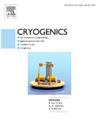Comparison study of three displacer type phase shifters in a two-stage Stirling type pulse tube refrigerator working around liquid hydrogen temperature
IF 2.1
3区 工程技术
Q3 PHYSICS, APPLIED
引用次数: 0
Abstract
With growing demand of high efficiency and compact cooling systems for the applications of space detectors, superconductivity and infrared detectors, pulse tube refrigerator (PTR) shows great promise. Ambient displacer phase shifter (AM-D) has gained popularity due to its compactness and recovering acoustic power. While achieving satisfied phase relationship and cooling efficiency remains challenging in multi-stage PTR operating below 20 K. Thus, cold displacer (CO-D) and thermal gradient displacer (TR-D) are proposed in this paper, which relocates the lower-stage displacer from ambient temperature to the upper-stage cold end. This could improve the phase shift ability and reduce the exergy losses in lower stage pulse tube. Theoretical analyses are first performed on phase shifting mechanism of three type displacer phase shifters. Following that, simulations are carried out to investigate the influence of displacer parameters, including compliance volumes, moving mass, spring stiffness and mechanical damper. Results indicate that PTR using CO-D or TR-D can achieve a cooling capacity of around 2.3 W, representing a 35 % increase over AM-D. Axial variations of phase relationship and acoustic power are compared, exergy losses and dual-temperature cooling capacities are then investigated. CO-D and TR-D phase shifters demonstrate the potential of attaining higher efficiency at liquid hydrogen temperature.
两级斯特林式脉冲管制冷机液氢温度下三种位移式移相器的比较研究
随着空间探测器、超导和红外探测器对高效、紧凑的冷却系统的需求日益增长,脉管制冷机(PTR)显示出巨大的发展前景。环境置换移相器(AM-D)因其结构紧凑、可回收声功率而受到广泛应用。然而,在20 K以下运行的多级PTR中,实现满意的相关系和冷却效率仍然是一个挑战。为此,本文提出了冷位移器(CO-D)和热梯度位移器(TR-D),将下级位移器从环境温度移至上级冷端。这样可以提高相移能力,降低低阶脉冲管的火用损失。首先对三种驱替式移相器的移相机理进行了理论分析。随后,进行了仿真研究,研究了位移器参数的影响,包括柔度体积、运动质量、弹簧刚度和机械阻尼器。结果表明,使用CO-D或TR-D的PTR可以实现约2.3 W的冷却能力,比AM-D增加35%。比较了相位关系和声功率的轴向变化,研究了火用损失和双温冷却能力。CO-D和TR-D移相器显示了在液氢温度下获得更高效率的潜力。
本文章由计算机程序翻译,如有差异,请以英文原文为准。
求助全文
约1分钟内获得全文
求助全文
来源期刊

Cryogenics
物理-热力学
CiteScore
3.80
自引率
9.50%
发文量
0
审稿时长
2.1 months
期刊介绍:
Cryogenics is the world''s leading journal focusing on all aspects of cryoengineering and cryogenics. Papers published in Cryogenics cover a wide variety of subjects in low temperature engineering and research. Among the areas covered are:
- Applications of superconductivity: magnets, electronics, devices
- Superconductors and their properties
- Properties of materials: metals, alloys, composites, polymers, insulations
- New applications of cryogenic technology to processes, devices, machinery
- Refrigeration and liquefaction technology
- Thermodynamics
- Fluid properties and fluid mechanics
- Heat transfer
- Thermometry and measurement science
- Cryogenics in medicine
- Cryoelectronics
 求助内容:
求助内容: 应助结果提醒方式:
应助结果提醒方式:


